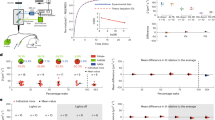Abstract
THE clinical syndrome of minimal brain dysfunction (MBD) in children is characterised by hyperactive motor behaviour, decreased attention span, impulsiveness and a variety of cognitive and perceptual problems. A striking feature of the disorder is the unusual response to stimulant medication. Thus, administration of amphetamine to children with MBD results in a sharp decrease in motor activity. Since the usual pharmacological response to amphetamine is an increase in motor activity, this response has been termed “paradoxical”1. We have described an experimental model in the developing rat that is strikingly similar to the clinical syndrome of MBD found in children2. Rat pups treated with 6-hydroxydopamine (6-OHDA) at 5 d of age develop increased motor activity and demonstrate cognitive difficulties in shuttle-box learning between 2 and 4 weeks of age. We now report that administration of (+)-amphetamine reduces the hyperactivity in 6-OHDA-treated rat pups, an effect paralleling the paradoxical response to this agent in children with MBD. The similarity of many of the cardinal features of MBD in an experimental model produced by depletion of brain dopamine in developing rats supports the belief that brain monoamines may be involved in the pathogenesis of this disorder.
This is a preview of subscription content, access via your institution
Access options
Subscribe to this journal
Receive 51 print issues and online access
$199.00 per year
only $3.90 per issue
Buy this article
- Purchase on Springer Link
- Instant access to full article PDF
Prices may be subject to local taxes which are calculated during checkout
Similar content being viewed by others
References
Wender, P. H., Minimal Brain Dysfuntion in Children, 184–190 (Wiley Interscience, New York, 1971).
Shaywitz, B. A., Yager, R. D., and Klopper, J. H., Science, 191, 305–308 (1976).
Breese, G. R., and Traylor, T. D., Br. J. Pharmac., 44, 210–222 (1972).
Smith, R. D., Cooper, B. R., and Breese, G. R., J. Pharmac. exp. Ther., 185, 609–619 (1973).
Hollister, A. S., Breese, G. R., and Cooper, B. R., Psychopharmacology, 36, 1–16 (1974).
Gray, J., Can. J. Psych., 19, 74–82 (1965).
Russell, P. A., Anim. Learn. Behav., 1, 278–282 (1973).
Roth, R. H., and Stone, E. A., Biochem. Pharmac., 17, 1581–1590 (1968).
Boadle-Biber, M. C., Hughes, J., and Roth, R. H., Br. J. Pharmac., 40, 702–720 (1970).
Snedecor, G. W., and Cochran, Statistical Methods, 104–106 (Iowa State College Press, Ames, 1967).
Heikkila, R. E., Orlansky, H., Mytilineou, C., and Cohen, G., J. Pharmac. exp. Ther., 194, 47–56 (1975).
Glowinski, J., and Axelrod, J., J. Pharmac. exp. Ther., 149, 43–49 (1965).
Coyle, J. T., and Snyder, S. H., J. Pharmac. exp. Ther., 170, 170, 221–231 (1969).
Thornburg, J. E., and Moore, K. E., Res. Commun. chem. Path., Pharmac., 5, 81–89 (1973).
Ziance, R. J., and Rutledge, C. O., J. pharmac. exp. Ther., 180, 118–126 (1972).
Kelly, P. H., Seviour, P. W., and Iversen, S. D., Brain Res., 94, 507–522 (1975).
Pignenburg, A. J. J., Honig, W. M. M., and Van Rossum, J. M., Psychopharmacology, 41, 87–95 (1975).
Roberts, D. C. S., Zis, A. P., and Fibiger, H. C., Brain Res., 93, 441–454 (1975).
Creese, I., and Iversen, S. D., Brain Res., 83, 419–435 (1975).
Creese, I., and Iversen, S. D., Brain Res., 55, 369–382 (1973).
Iversen, L. L., Science, 188, 1084–1089 (1975).
Kebabian, J. W., Bloom, F. E., Steiner, A. L., and Greengard, P., Science, 190, 157–159 (1975).
Sharpless, S. K., Fedn. Proc., 34, 1990–1997 (1975).
Mishra, R. K., Gardner, E. L., Katzman, R., and Makman, M. H., Proc. natn. Acad. Sci. U.S.A., 71, 3883–3887 (1974).
Shaywitz, B. A., Cohen, D. J., and Bowers, M. B., Pediat. Res., 9, 385 (1975).
Author information
Authors and Affiliations
Rights and permissions
About this article
Cite this article
SHAYWITZ, B., KLOPPER, J., YAGER, R. et al. Paradoxical response to amphetamine in developing rats treated with 6-hydroxydopamine. Nature 261, 153–155 (1976). https://doi.org/10.1038/261153a0
Received:
Accepted:
Issue Date:
DOI: https://doi.org/10.1038/261153a0
This article is cited by
-
Reinforcement, Dopamine and Rodent Models in Drug Development for ADHD
Neurotherapeutics (2012)
Comments
By submitting a comment you agree to abide by our Terms and Community Guidelines. If you find something abusive or that does not comply with our terms or guidelines please flag it as inappropriate.



